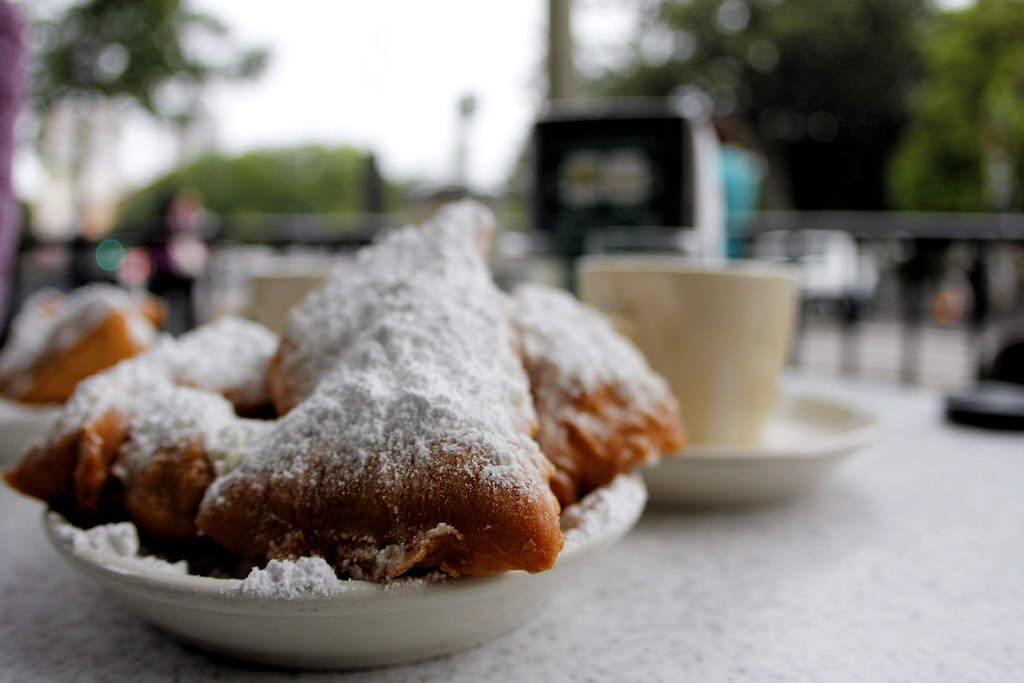Beignets are a type of deep-fried pastry that originated in France and are particularly associated with the city of New Orleans in the United States. They are similar in shape to doughnuts but are typically made with dough that is denser and chewier.
The dough for beignets is made from flour, yeast, milk, eggs, sugar, salt, and sometimes butter. It is rolled out and cut into squares or triangles before being deep-fried until golden brown. The finished beignets are then dusted with powdered sugar.
In New Orleans, beignets are often served with café au lait and are a popular breakfast or brunch item. They are also commonly found in other parts of the United States, particularly in areas with a strong French or Cajun influence. In addition, beignets have gained popularity in other countries, such as Japan and Vietnam, where they are sometimes made with savory fillings like shrimp or pork.
Overall, beignets are a delicious and beloved treat with a long history and a wide range of variations.
| Ingredients: | |
| 1 | 3 1/2 cups all-purpose flour |
| 2 | 1/2 cup granulated sugar |
| 3 | 2 1/4 tsp active dry yeast |
| 4 | 1 tsp salt |
| 5 | 1/2 cup warm water |
| 6 | 1/2 cup warm milk |
| 7 | 2 eggs, beaten |
| 8 | 2 tbsp unsalted butter, softened |
| 9 | Vegetable oil, for frying |
| 10 | Powdered sugar, for dusting |
Step-by-step cooking instructions of Beignets:
Step-1 In a large mixing bowl combines the flour, sugar, yeast, and salt.
Step-2 In a separate bowl, mix together the warm water, warm milk, beaten eggs, and softened butter.
Step-3 Add the wet ingredient to the dry ingredients and mix until smooth dough forms.
Step-4 Cover the dough and let it rest for 30 minutes.
Step-5 Heat vegetable oil in a deep fryer or heavy-bottomed pot until it reaches 350°F.
Step-6 On a lightly floured surface, roll out the dough to about 1/4 inch thickness. Cut the dough into 2-3 inch squares or triangles.
Step-7 The beignets should be fried in batches and turned over just once, until both sides are golden brown. It should take two to three minutes for each side.
Step-8 Using a slotted spoon transfers the beignets to a paper towel-lined plate to drain excess oil.
Step-9 Serve warm beignets dusted with powdered sugar.
Nutritional value of Beignets:
Here is an overview of the nutritional value of beignets:
Serving size: 1 beignet (about 2-3 inches square)
| 1 | Calories: Approximately 200-300 calories per beignet, depending on the size and recipe used. |
| 2 | Fat: Beignets are typically fried in vegetable oil, which adds fat to the pastry. A single beignet can contain up to 15-20 grams of fat, with most of it being saturated or trans fats. |
| 3 | Carbohydrates: Beignets are high in carbohydrates due to the use of flour and sugar in the recipe. A single beignet can contain up to 30-40 grams of carbohydrates. |
| 4 | Protein: Beignets are not a significant source of protein, with most recipes containing only a few grams per serving. |
| 5 | Fiber: Beignets are low in fiber, with most recipes containing less than 1 gram per serving. |
| 6 | Other nutrients: Beignets are not a significant source of vitamins or minerals, although they may contain small amounts of calcium, iron, and other nutrients depending on the ingredients used. |
Background History of Beignets:
The history of beignets dates back to the ancient Roman times when they were called “scriblita”. The word “beignet” itself comes from the French language and means “bump” or “swelling”. The French version of the beignet, also known as the “fritelle”, was made with fruit or nuts and was a popular treat in the French royal court.
Beignets became associated with New Orleans, Louisiana in the late 18th century when French colonists brought their recipes to the area. The dish became particularly popular during Mardi Gras, the annual carnival celebration in New Orleans. Today, beignets are often associated with the iconic Café du Monde in the French Quarter of New Orleans, where they have been served since 1862.
In addition to being a beloved treat in New Orleans, beignets have also become popular in other parts of the United States and around the world. In some regions, such as Vietnam and Japan, beignets are made with savory fillings such as shrimp or pork.
Overall, the history of beignets is one of cultural exchange and adaptation, with the pastry evolving and taking on new forms as it traveled from ancient Rome to France to the United States and beyond.
| Advantages of Beignets: | |
| 1 | Delicious taste: Beignets are a popular pastry that many people enjoy due to their sweet and chewy texture. |
| 2 | Versatile: Beignets can be made in a variety of flavors and styles, with sweet or savory fillings. |
| 3 | Easy to make: Beignets can be made at home with simple ingredients and basic cooking skills. |
| 4 | Popular cultural icon: Beignets are often associated with the culture and history of New Orleans, making them a beloved treat for locals and visitors alike. |
| Disadvantages of Beignets: | |
| 1 | High in calories: Beignets are a high-calorie food due to their deep-fried nature and the use of sugar and flour in the recipe. |
| 2 | High in fat: Beignets are typically fried in vegetable oil, which adds significant amounts of fat to the pastry. |
| 3 | Low in nutrients: Beignets are not a significant source of vitamins or minerals and lack fiber. |
| 4 | Potential health risks: Consuming high amounts of beignets on a regular basis can increase the risk of obesity, heart disease, and other health issues. |
Compare with similar meal of Beignets:
Beignets can be compared to other similar pastries and fried dough dishes from around the world. Here are a few examples:
| 1 | Donuts: Donuts are a popular pastry in the United States that are similar to beignets in that they are deep-fried and often coated in sugar. However, donuts are typically made with yeast dough and are shaped into a ring, whereas beignets are made with a choux pastry and are square or rectangular in shape. |
| 2 | Churros: Popular throughout Latin America and Spain, churros are fried dough pastries. Like beignets, they are deep-fried and often coated in sugar, but they are typically piped in a long, thin shape and may be filled with chocolate or other sweet fillings. |
| 3 | Zeppole: Zeppole are a traditional Italian pastry that are similar to beignets in that they are fried dough balls that may be coated in sugar. However, zeppole are often filled with custard or other sweet fillings, whereas beignets are typically served plain or with powdered sugar. |
| 4 | Loukoumades: Loukoumades are a Greek pastry that are similar to beignets in that they are fried dough balls. They are typically coated in honey or syrup and may be sprinkled with cinnamon or other toppings. |
Overall, while beignets share similarities with other pastries and fried dough dishes, their unique choux pastry dough and square shape make them a distinct and beloved treat in their own right.
Mostly questions asked about Beignets:
Q: What is a beignet?
A: A beignet is a French-style pastry that is made from choux pastry dough, which is deep-fried and then sprinkled with powdered sugar.
Q: Where did beignets originate?
A: Beignets originated in France, but became popular in New Orleans, Louisiana in the United States, where they are often associated with the city’s Mardi gras celebrations.
Q: What are the ingredients in a beignet?
A: The main ingredients in a beignet include flour, butter, eggs, water, and yeast. They may also include sugar, salt, and milk.
Q: What is the texture of a beignet?
A: Beignets have a soft, chewy texture on the inside, with a crispy outer layer that is slightly crunchy.
Q: What is the best way to eat a beignet?
A: Beignets are often served warm and fresh, sprinkled with powdered sugar. They are typically enjoyed with coffee or hot chocolate.
Q: Can beignets be made gluten-free?
A: Yes, it is possible to make beignets using gluten-free flour, although the texture may be slightly different than traditional beignets.
Q: Are beignets vegan?
A: Beignets are typically made with eggs and butter, which are not vegan. However, it is possible to make vegan beignets using plant-based substitutes for these ingredients.
Q: Are beignets healthy?
A: Beignets are a high-calorie, high-fat food that is not considered to be healthy. They ought to be consumed in moderation as a component of a healthy diet.
Q: What do beignets smell like?
A: The perfume of sweetened buttermilk, pure vanilla extract, and top notes of powdered sugar fills the air as you open the bag of beignets.
Q: Do beignets expire?
A: Beignets really are best served fresh, but if you have any leftover you can keep them in an airtight container on the counter for 2-3 days or even freeze them for 1-2 months.







